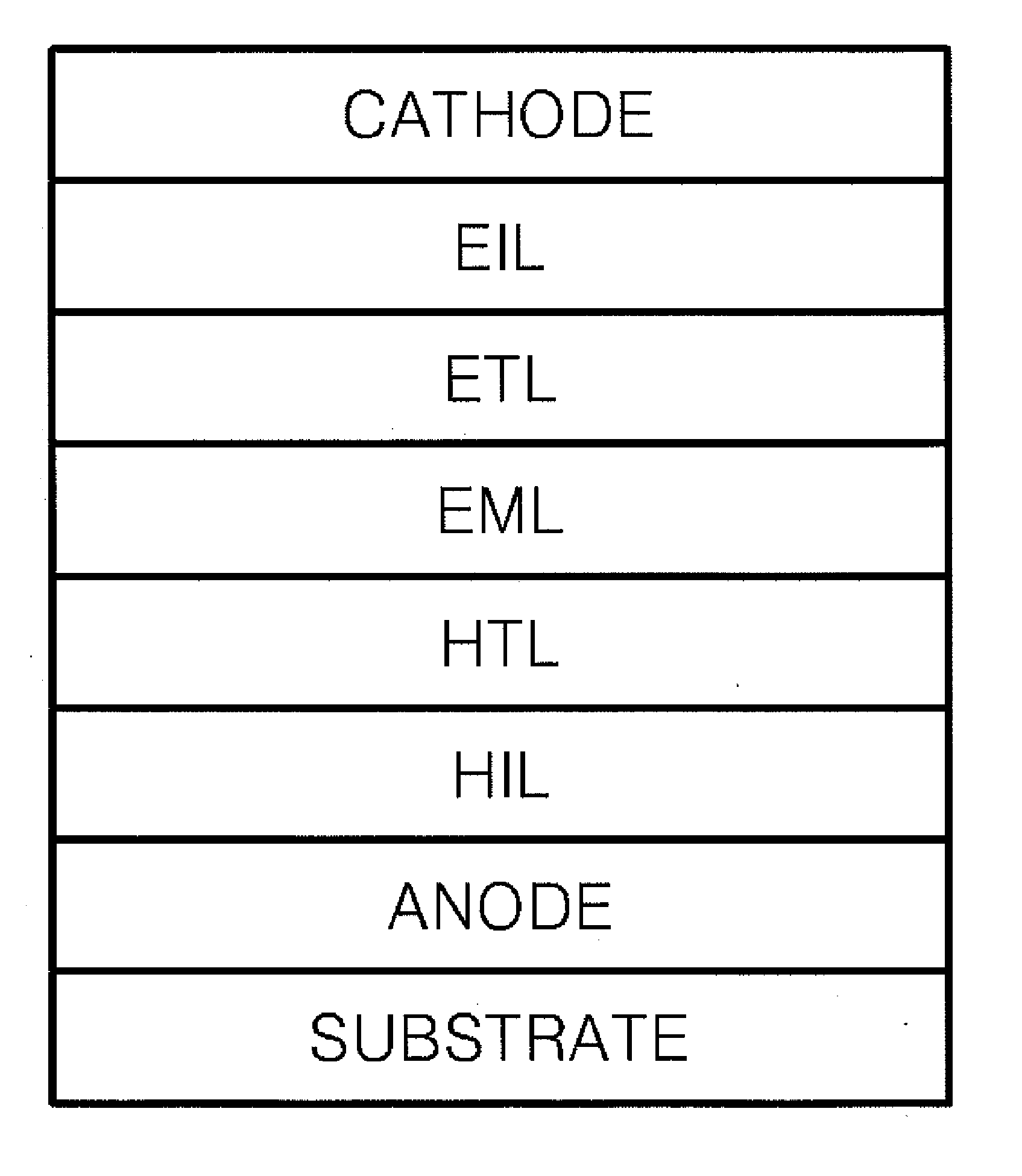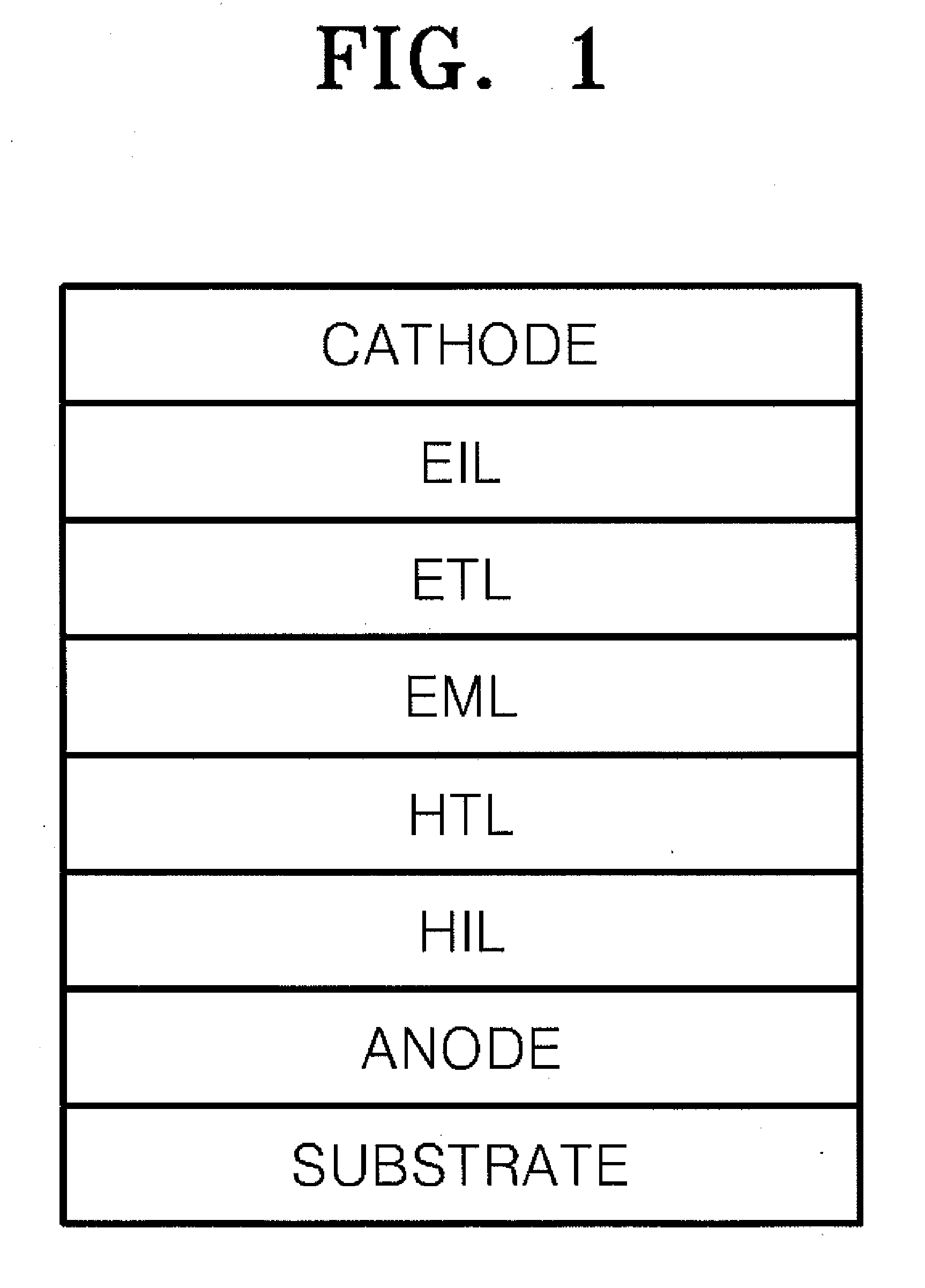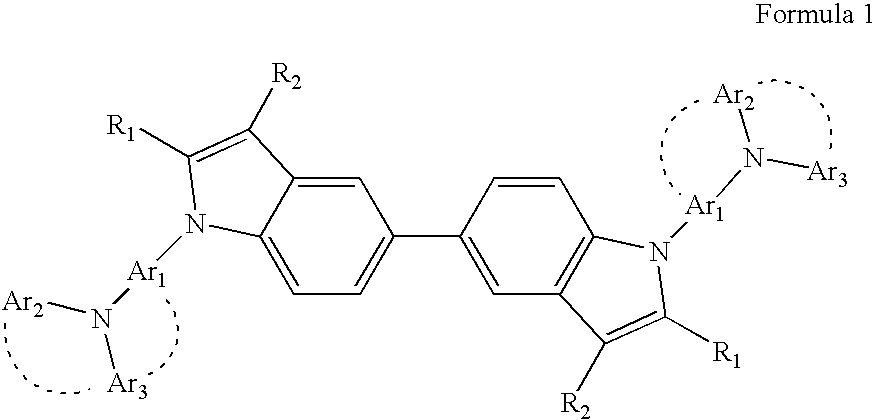Heterocyclic compound and organic electroluminescent device comprising the same
a technology of organic electroluminescent devices and compound compounds, which is applied in the direction of discharge tubes/lamp details, organic chemistry, discharge tubes luminescnet screens, etc., can solve the problems that the life, efficiency and power consumption of conventional electroluminescent devices employing hole injection layers and/or hole transport layers still needs to be improved, so as to achieve high charge transporting capability, high glass transition temperature, and high electrical stability
- Summary
- Abstract
- Description
- Claims
- Application Information
AI Technical Summary
Benefits of technology
Problems solved by technology
Method used
Image
Examples
synthesis example 1
Preparation of Compound 1
[0069]Compound 1 was synthesized through a reaction pathway illustrated in Reaction Scheme 1 below.
[0070][31.2 g of dibromo biphenyl (0.10 mole) and 43.2 g of benzophenone hydrazone (0.22 mole) were dissolved in 400 ml of toluene. Then, 1.12 g of Pd(OAc)2 (5.0 mole %), 2.6 g of phosphine ligand (5.5 mole), and 28.8 g of NaOtBu (0.30 mole) were added to the mixture and the resultant mixture was stirred while refluxing for 12 hours in a nitrogen atmosphere. After the reaction was terminated, methylene chloride was added to the reaction solution at room temperature and the resultant solution was filtered using cellite. The solution was then extracted using 50 ml of ethylether three times. The collected organic layer was dried over magnesium sulfate and a solvent was evaporated to obtain the residue. The residue was purified by silicagel column chromatography to obtain 4.21 g (yield 85%) of a white solid Intermediate A.
[0071]1H NMR (CD2Cl2, 400 MHz) δ (ppm) 7.52...
synthesis example 2
Preparation of Compound 7
[0078]Compound 7 was synthesized through a reaction pathway illustrated in Reaction Scheme 2 below.
[0079]6.58 g of 1-naphthyl-phenylamine (30.0 mmole) and 12.7 g of 4-bromoiodobenzene (45.0 mmole) were dissolved in 150 ml of toluene. Then, 550 mg of Pd2dba3 (2.0 mole %), 300 mg of phosphine ligand (2.0 mole %), and 4.32 g of NaOtBu (45.0 mole) were added to the mixture and the resultant mixture was stirred while refluxing for 4 hours in a nitrogen atmosphere. After the reaction was terminated, water was added to the reaction solution at room temperature and the resultant solution was extracted using 200 ml of methylene chloride twice. The collected organic layer was dried over magnesium sulfate and a solvent was evaporated to obtain the residue. The residue was purified by silicagel column chromatography to obtain 4.7 g (yield 42%) of a light yellow solid Irtermediate C.
[0080]1H NMR (CD2Cl2, 400 MHz) δ (ppm) 7.63 (d, 2H), 7.01-7.30 (m, 8H), 6.35-6.62 (m, 6H)...
synthesis example 3
Preparation of Compound 9
[0084]Compound 9 was synthesized through a reaction pathway illustrated in Reaction Scheme 3 below.
[0085]Intermediate D (yield 45%) was synthesized using the method similar to that used in the synthesis of Intermediate C.
[0086]1H NMR (CD2Cl2, 400 MHz) δ (ppm) 7.51-7.44 (m, 2H), 7.01-7.23 (m, 8H), 6.35-6.76 (m, 6H); 13C NMR (CD2CL2, 100 MHz) δ (ppm) 142.6, 141.6, 140.4, 133.5, 132.7, 129.4, 127.8, 126.6, 126.4, 125.0, 124.5, 123.7, 122.9, 121.5, 121.1, 117.5, 117.0, 107.4.
[0087](2) Synthesis of Compound 9
[0088]Compound 9 (yield 73%) was synthesized using the same method as that used in the synthesis of Compound 1, except that Intermediate D was used instead of 4-bromophenyl-diphenyl amine.
[0089]1H NMR (CD2Cl2, 400 MHz) δ (ppm) 7.76-7.80 (m, 6H), 7.65 (d, 2H), 7.54 (d, 2H), 7.20-7.46 (m, 28H), 7.10 (t, 2H), 2.37 (s, 6H), 2.29 (s, 6H); 13C NMR (CD2Cl2, 100 MHz) δ (ppm) 147.5, 146.8, 145.1, 136.4, 134.7, 134.4, 133.4, 132.5, 130.3, 129.4, 129.2, 129.1, 128.6, 12...
PUM
| Property | Measurement | Unit |
|---|---|---|
| Electric charge | aaaaa | aaaaa |
| Efficiency | aaaaa | aaaaa |
| Fluorescence | aaaaa | aaaaa |
Abstract
Description
Claims
Application Information
 Login to View More
Login to View More - R&D
- Intellectual Property
- Life Sciences
- Materials
- Tech Scout
- Unparalleled Data Quality
- Higher Quality Content
- 60% Fewer Hallucinations
Browse by: Latest US Patents, China's latest patents, Technical Efficacy Thesaurus, Application Domain, Technology Topic, Popular Technical Reports.
© 2025 PatSnap. All rights reserved.Legal|Privacy policy|Modern Slavery Act Transparency Statement|Sitemap|About US| Contact US: help@patsnap.com



